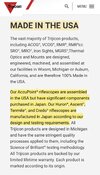Just ran across an interesting article discussing optic scope quality of riflescopes & glass origin. Keeping in mind this is just their opinion and doesn’t change mine as I judge riflescopes on whether a
 type or brand or type works under low-light conditions in the field, ability to hold zero & predictable or repeatable dial response.
type or brand or type works under low-light conditions in the field, ability to hold zero & predictable or repeatable dial response.
There is a comment that Leupold uses Japanese glass in their US mf’d scopes, as well as many USA scopes using Japanese glass, etc. BTW, Steiner is also owned by Beretta.
Site is snipercountry.com & titled “Long Range Optics Brands Ranked”.
 type or brand or type works under low-light conditions in the field, ability to hold zero & predictable or repeatable dial response.
type or brand or type works under low-light conditions in the field, ability to hold zero & predictable or repeatable dial response.There is a comment that Leupold uses Japanese glass in their US mf’d scopes, as well as many USA scopes using Japanese glass, etc. BTW, Steiner is also owned by Beretta.
Site is snipercountry.com & titled “Long Range Optics Brands Ranked”.

Last edited:
